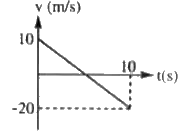A force →F=5ˆi−3ˆj+2ˆk moves a particle from →r1=2ˆi+7ˆi+4ˆk to →r2=5ˆi+2ˆj+8ˆk. Calculate the workdone. Solution in Telugu
38 units
20 units
30 units
15 units
The correct Answer is:A
Step by step video, text & image solution for A force vec(F) = 5hat(i) - 3hat(j) + 2hat(k) moves a particle from vec(r_(1))=2hat(i)+7hat(i)+4hat(k)" ""to" " " vec(r_(2))=5hat(i)+2hat(j)+8hat(k). Calculate the workdone. by Physics experts to help you in doubts & scoring excellent marks in Class 11 exams.
Updated on:21/07/2023Topper's Solved these Questions
- WORK, POWER & ENERGY BOOK - AAKASH SERIESCHAPTER - WORK, POWER & ENERGY EXERCISE - EXERCISE - II (WORK)
20 Videos
- WORK, POWER & ENERGY BOOK - AAKASH SERIESCHAPTER - WORK, POWER & ENERGY EXERCISE - EXERCISE - II (ENERGY)
33 Videos
- WORK, POWER & ENERGY BOOK - AAKASH SERIESCHAPTER - WORK, POWER & ENERGY EXERCISE - EXERCISE - I
78 Videos
- WORK POWER ENERGYBOOK - AAKASH SERIESCHAPTER - WORK POWER ENERGYEXERCISE - EXERCISE - 3
61 Videos
Similar Questions
The length of a smooth inclined plane of incilination 30∘ is 5 m. The work done is moving a 10kg mass from the bottom of the inclined plane to top is
View SolutionVelocity - time graph of a particle moving in a straight line is as shown in figure. Mass of the particle is 2 kg. Work done by all the forces acting on the particle in time interval between t = to t = 10 is

View SolutionIf l1,m1,n1 and l2,m2,n2 are the direction cosines of two vectors and θ is the angle between them, then the value of cos θ is
View SolutionIf →A+→B=→Rand2→A+→B is perpendicular to →B then
View Solutionvec r=(4hat i-hat j)+lambda(hat i+2hat j-3hat k) and vec r=(hat i-hat j+2hat k)+mu(2hat i+4hat j-5hat k)
View Solutiona. Calculate →r=→a−→b+→c, where →a=5ˆi+4ˆj−6ˆk,
→b=−2ˆi+2ˆj+3ˆk, and →c=4ˆi+3ˆj+2ˆk.
b. Calculate the angle between →r and the z-axis.
View SolutionThe three vector vec(A) = 3hat(i)-2hat(j)+hat(k), vec(B)= hat(i)-3hat(j)+5hat(k) and vec(C )= 2hat(i)+hat(j)-4hat(k) from
View SolutionShow that the vectors →a,→b,→c are coplanar, when
(i) →a=ˆi−2ˆj+3ˆk,→b=−2ˆi+3ˆj−4ˆkand→c=ˆi−3ˆj+5ˆk
(ii) →a=ˆi+3ˆj+ˆk,→b=2ˆi−ˆj−ˆkand→c=7ˆj+3ˆk
(iii) →a=2ˆi−ˆj+2ˆk,→b=ˆi+2ˆj−3ˆkand→c=3ˆi−4ˆj+7ˆk
View Solutionएकांक सदिशों के लिए
→ˆi׈i=ˆj׈j=ˆk׈k=0
→ˆi׈j=ˆk,ˆj׈k=ˆi,ˆk׈i=ˆj
→ˆj׈i=−ˆk,ˆi׈k=−ˆj,ˆk׈j=−ˆi
तब निम्न प्रश्नों के उत्तर दीजिए
यदि →a=2ˆi−3ˆj−5ˆk तथा →b=−7ˆi+6ˆj+8ˆk, तब →a×→b ज्ञात करें ।
View Solutionसिद्ध कीजिए कि सदिश →a=ˆi−2ˆj+3ˆk,→b=−2ˆi+3ˆj−4ˆk और →c=ˆi−3ˆj+5ˆk समतलीय है।
View SolutionShow that the following vectors are coplanar :
3ˆi−2ˆj+4ˆk,6ˆi+3ˆj+2ˆk,5ˆi+7ˆj+3ˆk and 2ˆi+2ˆj+5ˆk.
View SolutionShow that the vectors :
→a=ˆi−2ˆj+3ˆk,→b=−2ˆi+3ˆj−4ˆk and →c=ˆi−3ˆj+5ˆk are coplanar.
View SolutionFind ∣∣→a×→b∣∣, if →a=2ˆi+ˆj+3ˆk and →b=3ˆi+5ˆj−2ˆk.
View Solutionयदि −−→OA=4ˆi−3ˆj+5ˆk,−−→OB=7ˆi−5ˆj−ˆk,−−→OC=−2ˆi+ˆj+3ˆk,−−→OD=3ˆi+2ˆj+5ˆk तब सदिश −−→AB पर −−→CD सदिश का प्रक्षेप ज्ञात कीजिए।
View SolutionA force vec(F)=5hat(i)-3hat(j)+2hat(k) moves a particle from vec(r_(1))=2hat(i)+7hat(j)+4hat(k) to vec(r_(2))=5hat(i)+2hat(j)+8hat(k) . Calculate the workdone.
View Solution
